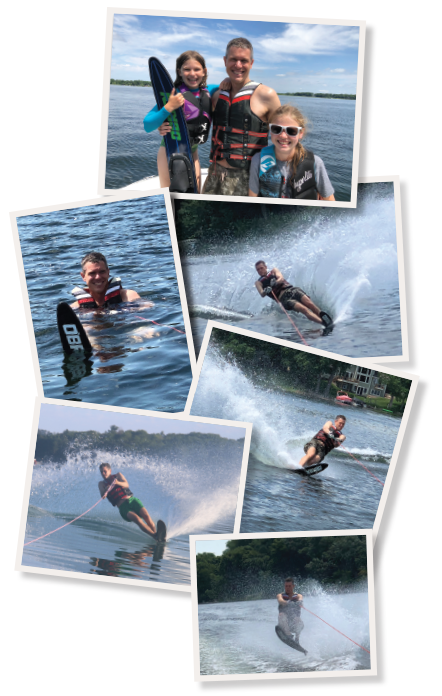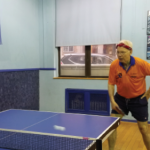
TOP: Dr. Binstadt with his daughters, Annika (left) and Kensi, on White Bear Lake in Minnesota.
LEFT: Dr. Binstadt getting ready to water ski on White Bear Lake.
RIGHT: Dr. Binstadt waterskiing at Little Glen Lake in Michigan.
Years ago, 16-year-old Bryce Binstadt, now a pediatric rheumatologist at the University of Minnesota Masonic Children’s Hospital, was waterskiing with friends on Potato Lake in Minnesota, where his family frequently vacationed. Dr. Binstadt had been an avid water-skier since he was 8 years old and had become very skilled at the sport—even skiing backward. This day, the unexpected happened.
As he was leaning over to glide into a turn, something he had done hundreds of times in the past, he suddenly felt the right side of his body bounce off the surface of the water. Once, twice, three times. After a few seconds, he realized the ski rope he was still holding that connected him to the boat had snapped, forcing his body to skip across the lake like a stone instead of pulling him back into an upright position.
Other than a few bruises, he escaped serious injury. Still, that intimidating experience was not enough for him to abandon the sport he loved. Every summer, you can find Dr. Binstadt on different lakes in Minnesota and Michigan, participating in a sport he calls “exhilarating.”
Day Jobs
Back in 1999, Dr. Binstadt earned two advanced degrees: an MD from the Mayo Clinic School of Medicine and a PhD in immunology from the Mayo Clinic Graduate School of Biomedical Sciences, both in Rochester, Minn. His research focused on natural killer cells and the molecular biology of how they get activated.
As he learned more about the body’s immune system, he became interested in autoimmune diseases. But it wasn’t until his fourth year of medical school during a rotation in pediatric rheumatology that he really solidified his decision to become a pediatric rheumatologist.
During the next three years, he completed a combined residency program at Boston Children’s Hospital and Boston Medical Center. From 2002 to 2005, he moved on to the next step in his career by completing a pediatric rheumatology fellowship at Boston Children’s Hospital.
“When I was a college sophomore, junior and senior, I became interested in immunology through summer research experiences,” says Dr. Binstadt, who accepted a position at the University of Minnesota (UMN) in 2007 as an assistant professor of pediatrics and is now a distinguished university teaching professor in the Division of Rheumatology in the Department of Pediatrics at the School of Medicine.
Since then, his credentials and experiences have continued to pile up. He serves as the pediatric rheumatology fellowship director at UMN, chairs the Scientific Advisory Council of the Rheumatology Research Foundation and is a member of the ACR’s Committee on Research.
‘Physicians need to have something other than work to do that’s a fun hobby.’ —Dr. Binstadt
Family Fun
Dr. Binstadt says waterskiing helps him relax, is fun and helps clear his mind. But it has another benefit, too. Since he cares for pediatric patients, he says talking about the sport helps him better relate to them.
“It’s important for kids to be active,” he says. “If they ask me what things I do, I give them a list of activities that includes waterskiing. This is what motivates me to stay in shape.”
Waterskiing is physically demanding, and at age 48, Dr. Binstadt feels the stress and strain on his body. To help stay fit year-round, he runs almost five miles, up to five times each week, occasionally competes in 5K races, lifts weights and plays tennis with his two daughters—13-year-old Kensi and 10-year-old Annika. Dr. Binstadt says he played Division III college tennis and is still “pretty good.”
His wife, Emily, an emergency medicine physician, and daughters also water ski. Since his family belongs to a club off a lake that rents motorboats, waterskiing on weekends has become a family priority. Even the family dog, a 4-year-old Vizsla named Penny, enjoys her own water sport—floating on an inner tube.
Over the years, Dr. Binstadt has learned a few ski tricks. He can slalom, jump over the wake of the boat and ski backward. He’s now teaching himself wakeboarding, which is a relatively new sport. People strap their feet onto a short, wide board that resembles a surfboard, are pulled behind a motorboat and—if gutsy—perform acrobatic maneuvers.
His advice to novice water-skiers is to keep at it. “I’ve never seen anyone get up on the first try,” he says. “It takes repetition. You have to bend your knees and let the boat do the work to pull you up.”
One downside, at least in Stillwater, Minn., where he and his family live: The season for the sport is too short. Unless you wear a wetsuit, people can only water ski from June through mid-September.
“Physicians need to have something other than work to do that’s a fun hobby,” says Dr. Binstadt. “There’s the physical thrill of waterskiing, an adrenaline rush that no other sport or activity gives me. It keeps me focused.”
Carol Patton is a freelance writer based in Las Vegas.


